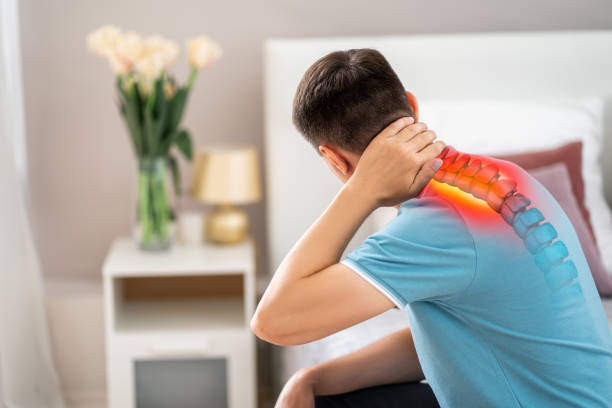
Disc problems refer to issues affecting the intervertebral discs, which are the soft, cushion-like structures located between the vertebrae of the spine. These discs have a gel-like center (nucleus pulposus) surrounded by a tough outer layer (annulus fibrosus). Disc problems can arise when there is damage or degeneration in these discs, leading to pain and other symptoms.
The two primary disc problems are:
1. Herniated disc (also called a slipped or ruptured disc): This occurs when the inner gel-like material (nucleus pulposus) protrudes through a tear or weakened area in the outer layer (annulus fibrosus) of the disc. A herniated disc can put pressure on nearby nerves, causing pain, numbness, tingling, or weakness in the area of the body supplied by those affected nerves.
2. Degenerative disc disease: This condition refers to the gradual deterioration or breakdown of the intervertebral discs over time. As discs lose their water content and structural integrity, they may become thinner, less flexible, and less effective in cushioning the vertebrae. This can lead to pain, stiffness, and reduced mobility in the affected area.
Homeopathy offers side-effect-free treatment for disc problems, effectively halting degeneration. Natural remedies provide pain relief, with treatment tailored to individual symptoms. Seek homeopathic care for disc problems and experience holistic healing.
At Wellness Homeo Clinic International, our expert Homeopaths offer personalized Constitutional Homeopathy Treatment for Disc Problems. After analyzing symptoms and health condition, they prescribe suitable homeopathic remedies. This treatment not only effectively controls the condition but also addresses the root cause for long-term relief and enhances overall well-being.
Disc problems can manifest in various ways, and the specific symptoms can vary depending on the severity and location of the issue. Here are some common symptoms associated with disc problems:
Disc problems can occur due to various factors. Here are some common causes of disc problems:
Intervertebral disc degeneration is a condition in which the gel-like material between the vertebrae, known as intervertebral discs, deteriorates over time. This degeneration can occur due to factors such as aging, repetitive stress, smoking, genetics, and other contributing factors.
A disc acts as a shock absorber between vertebrae. Deterioration can cause bulging, slipping, rupturing, or herniation, resulting in pressure on the spinal cord or nerve roots. Herniation occurs when a disc fragment is displaced from its normal position. Bulging discs are also a common condition.
In many cases, bulging discs are a natural part of aging and do not cause symptoms. Elderly individuals often experience bulging discs due to the wear and tear their bodies undergo over time. In such cases, these bulging discs can be considered a normal occurrence. As long as they do not result in symptoms, adults can lead normal lives without significant issues.
In cases of progressive, severe, and disabling back pain, surgery is often a viable option. Symptoms such as numbness, tingling, and weakness suggest nerve compression, which may require prompt treatment to prevent permanent nerve damage. It is important to seek medical attention to evaluate the need for surgical intervention and prevent long-term complications.
Spinal conditions that commonly lead to low back pain include herniated discs, spinal stenosis, scoliosis, kyphosis, muscle strain or spasm, and fractures of the spine due to osteoporosis.